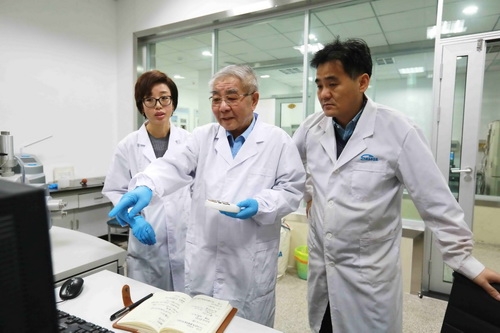One of the Innovation Team winners in this year’s China National Science and Technology Awards is a team that has been researching construction on permafrost for almost half a century and made the completion of Qinghai-Tibet Railway possible in 2006.
For the railway on the world's highest plateau, the biggest challenge was the unstable terrain of permafrost. One of the people who solved that problem was Cheng Guodong.
Since graduating in the 1960s, Cheng has been following his predecessors and researching permafrost. The development of the railway line went through twists and turns, but he never gave up.
Cheng's research focuses on infrastructure construction projects in regions which have permafrost, such as the building of railways and highways. It's quite a complex line of work for his team.

Cheng Guodong and his team researching permafrost at the Chinese Academy of Sciences based in Lanzhou, Gansu Province. /Photo via Cold and Arid Regions Environmental and Engineering Research Institute, Chinese Academy of Sciences
The construction of the Qinghai-Tibet Railway started in 1958. Despite the permafrost, the ground on the surface of the plateau does melt, with the ground expanding when it freezes and turning into slush when it thaws. This threatens to deform and destroy any construction built on it, including the railway, so the roadbed soils need to be kept frozen.
According to Cheng, there are three major ways to keep permafrost stable, namely regulating the radiation, the convection or conduction patterns of heat.
Cheng said they used many ways to increase efficiency that were environmentally-friendly, low-cost, and easy to adopt, and they constantly made changes due to new conditions.
More projects are planned for the plateau, including an expressway and an oil pipeline. And knowledge gleaned from a surprising discovery just 200 kilometers from Beijing will help.
Niu Fujun, a member of Cheng’s team said they recently went out for a study in Chengde in north China's Hebei Province, and unexpectedly discovered permafrost only two meters below ground level.
The means annual air temperature there is 7.8 degrees Celsius. So they made comparisons to the conditions of the permafrost under the railway on the plateau.
Research is needed to make sure the cooling system for the Qinghai-Tibet Railway works even when temperatures rise due to global warming.
And their mission goes beyond that. A new railway linking China and Russia has also been added to the agenda.
"If the railway is completed, a lot can be transported along it, but the regions it crosses are basically frozen," said Cheng.
To complete this railway, which is intended to cross Asia and Europe, the team is expanding its cooperation with other countries and will hold an International Conference on Permafrost in 2020.
Cheng said he is glad his team won a national award, and he hopes more funds will be given to scientists, especially those in China's vast western regions. (CGTV)

